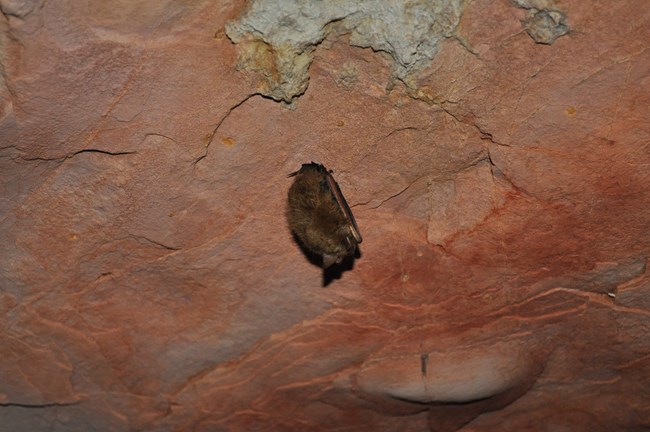Last updated: March 14, 2024
Article
Bat Monitoring at Isle Royale, 2015–2019

NPS photo
Bats nationwide are struggling to survive against threats posed by climate change, habitat loss, wind turbines, and a devastating fungal disease called white-nose syndrome (WNS).
Three of the seven bat species on Isle Royale are here in the summer, but then migrate to the southwestern U.S., Mexico, and even Central America for the winter. The other four species do not migrate. Instead, they hibernate here over the winter, roosting in buildings and mine shafts. These hibernating species—the little brown, northern long-eared, and tricolored bats—are highly susceptible to WNS. The big brown bat is also a hibernating species but has exhibited resistance to the disease.
Prior to the initiation of the our monitoring program, a total of seven bat species were documented on the island (Table 1). The oldest report, from 1906, states that little brown bats “were the only bats seen on the island.” The little brown and three others (northern long-eared, big brown, and eastern red bats) were included on wildlife species lists in 1970 and 1982, but no details were provided except for a report of red bats seen mating near the Rock Harbor Lodge in late summer 1970.
The first targeted bat survey on Isle Royale was completed in 2002, documenting six species using a combination of mist-netting and acoustic recording. Big brown, little brown, and northern long-eared bats were captured; the calls of eastern red, silver-haired, hoary, little brown, and northern long-eared bats were recorded. Acoustic surveys were also done by park staff in 2011, 2012, and 2014, gathering additional records of the same six species found in 2002.
Another trapping effort in 2013 resulted in captures of just two species: little brown and northern long-eared. As part of a Department of Energy project, acoustic monitors were placed at the Ojibway fire tower in 2012 and 2013 and at Rock of Ages lighthouse in 2012. The calls that could be identified to the species level came from silver-haired, hoary, eastern red, and big brown bats.
Isle Royale is near the edge of the tricolored bat’s range. There are records of this species hibernating in Keweenaw County, Michigan, and at Palisade Head near Silver Bay, Minnesota. Three dead tricolored bats were collected on the island, one in the 1970s and two in 2012. However, we are still uncertain if this species is a regular summer resident.
Table 1. Bat species documented at Isle Royale before the start of this monitoring program in 2015 and after five years of acoustic monitoring (2019). Asterisk (*) indicates winter hibernating species.
| Common Name | Scientific Name | Pre-2015 | 2019 |
|---|---|---|---|
| Big Brown Bat * | Eptesicus fuscus | Yes | Yes |
| Eastern Red Bat | Lasiurus borealis | Yes | Yes |
| Hoary Bat | Lasiurus cinereus | Yes | Yes |
| Little Brown Bat * | Myotis lucifugus | Yes | Yes |
| Northern Long-eared Bat * | Myotis septentrionalis | Yes | Yes |
| Silver-haired Bat | Lasionycteris noctivagans | Yes | Yes |
| Tricolored Bat * | Perimyotis subflavus | Yes | Yes |

Breaking the Ultrasonic Barrier
Beginning in 2015, we placed ultrasonic audio recorders throughout the park to identify what bat species are present. Bats give different calls while in flight to help them navigate and to locate things like food. Like bird songs, we can identify bat species by their calls, but the calls are ultrasonic—beyond the range of human hearing—so special microphones and software are used to record and identify them. But, also like birds, some bat species have similar calls, and there can be variation in the calls of any one species. As a result, the software we use to analyze and identify the recordings is not 100% accurate. In these cases, a proportion of call files are reviewed “manually” using a spectrogram to verify the identifications.
Who Is Out There?
The seven bat species previously documented at the park were reconfirmed through both automated and manual identification of calls (Table 1). All seven species were recorded every year, including the tricolored bat, though tricolored bats comprised fewer than 1% of the total call files each year.
Little brown bats were the most commonly recorded species in 2015–2017, but then dropped to about 20% of the total in the last two years. More than 100 little brown bat calls were recorded per night at seven sites in 2016, but no site reached that level of activity in any other year.
A site on the Greenstone Ridge Trail west of Chickenbone Lake had the highest number of big brown bat calls per recording night of all sites in 2016–2019. Its location in a forest opening may provide good foraging opportunities.
Activity levels for big brown, hoary, and silver-haired bats appear to be stable or increasing slightly, while eastern red, little brown, northern long-eared, and tricolored bats show decreasing activity trends during the five-year period.
The Future of Bat Monitoring
When this project began, the Great Lakes region was at the leading edge of the WNS spread. This monitoring program helped parks to document baseline data on their bat populations and to assess changes over time.
We are working with the NABat Midwest Bat Hub (https://midwestbathub.nres.illinois.edu/) to create statistical models of bat occupancy, particularly those most affected by WNS. Occupancy measures the probability that a species is using an area, while taking into account the fact that we cannot always perfectly detect the species.
The Great Lakes Network handed over the equipment and responsibility for coordinating bat monitoring to Isle Royale staff in 2023.

NPS photos unless credited otherwise.
